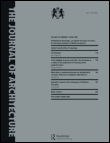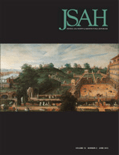
Journal of Architecture
metrics 2024
Illuminating the evolving landscape of architectural thought.
Introduction
Journal of Architecture, published by ROUTLEDGE JOURNALS, TAYLOR & FRANCIS LTD, stands as a pivotal platform for scholarly discourse in the ever-evolving field of architecture. Established in 1996, this esteemed journal boasts an impressive impact factor, categorized as Q2 in Architecture and Q1 in Visual Arts and Performing Arts, reflecting its significant contribution to both disciplines. With a robust Scopus ranking positioning it in the 85th percentile among Visual Arts and Performing Arts and the 57th percentile within Engineering Architecture, the journal serves as an essential resource for researchers, professionals, and students alike. The Journal of Architecture features innovative research and thoughtful analysis that shape contemporary architectural practices and theories, encouraging interdisciplinary dialogue. Engaging with this journal allows readers to stay abreast of critical advancements and emerging trends, fostering a deeper understanding of architecture's role in societal transformation.
Metrics 2024
 0.18
0.18 0.60
0.60 0.70
0.70 23
23Metrics History
Rank 2024
Scopus
JCI (Web Of Science)
Quartile History
Similar Journals

ARCHITECTURAL DESIGN
Elevating Architectural ConversationsARCHITECTURAL DESIGN, a leading journal published by Wiley Periodicals, Inc., serves as a vital platform for discourse in the fields of architecture and visual arts. With an ISSN of 0003-8504 and an E-ISSN of 1554-2769, this esteemed publication offers comprehensive insights into contemporary design practices and emerging architectural theories. Established in the United States and continuously evolving from 2002 to 2024, the journal has secured a prominent position with a Q3 status in Architecture and an impressive Q1 ranking in Visual Arts and Performing Arts as of 2023. Its Scopus rankings further affirm its relevance, with a percentile ranking of 82nd in the Visual Arts category. Although it does not currently offer Open Access options, the journal remains dedicated to disseminating high-caliber research and innovative design strategies that engage a diverse readership of researchers, professionals, and students alike. The contributions published within its pages are instrumental in shaping the discourse around architecture, making ARCHITECTURAL DESIGN an indispensable resource for anyone passionate about the built environment.

En Blanco-Revista de Arquitectura
Fostering Dialogue Among Architects and DesignersEn Blanco - Revista de Arquitectura is a peer-reviewed journal published by UNIV POLITECNICA VALENCIA, EDITORIAL UPV, specializing in the field of architecture and design. This esteemed publication aims to bridge theoretical advances and practical applications within the architecture domain, showcasing innovative research, critical essays, and multidisciplinary approaches. With an emphasis on fostering dialogue among researchers, professionals, and students, En Blanco serves as an essential platform for disseminating cutting-edge ideas and discussions that define contemporary architectural practices. Although currently offering non-open access content, the journal is dedicated to promoting accessibility through insights that resonate beyond its pages. With an ISSN of 1888-5616 and E-ISSN of 2445-1215, En Blanco is a pivotal resource for any architecture enthusiast looking to enrich their understanding and contribute to the evolving discourse in architectural studies.

METU Journal of the Faculty of Architecture
Unveiling contemporary architectural practices and theories.METU Journal of the Faculty of Architecture is a reputable academic publication dedicated to advancing research and discourse in the field of architecture. Published by MIDDLE EAST TECHNICAL UNIVERSITY in Turkey, this journal serves as a vital platform for scholars and practitioners, addressing both theoretical and practical topics relevant to contemporary architectural studies. With an impact factor that positions it in the Q3 category for architecture as of 2023, and a Scopus rank of #133 out of 189 in Engineering Architecture, the METU Journal is an influential resource for innovative ideas and studies. Encompassing a wide range of scholarly articles, it fosters academic collaboration between researchers and professionals, making it essential reading for anyone passionate about the evolution of architecture. Though not open access, it provides crucial insights and rigorous research from 2008 up until 2024, contributing significantly to the global discourse on architectural practices and theories.

ICONARP International Journal of Architecture and Planning
Fostering global collaboration in architectural scholarship.ICONARP International Journal of Architecture and Planning is an esteemed open-access publication that serves as a pivotal platform for fostering innovative research and discussions in the fields of architecture and urban design. Published by KONYA TECHNICAL UNIVERSITY, FACULTY OF ARCHITECTURE & DESIGN, this journal has been committed to the dissemination of high-quality academic work since 2013, promoting accessibility and global collaboration among researchers, professionals, and students. With its rigorous peer-review process and a focus on contemporary architectural and planning challenges, ICONARP seeks to contribute significantly to scholarly discourse and practical applications within the built environment. The journal is indexed in various scientific databases, enhancing its visibility and impact in the academic community. By appealing to a diverse audience, ICONARP encourages interdisciplinary studies and innovative solutions that address the complexities of modern architecture and urban living.

JOURNAL OF THE SOCIETY OF ARCHITECTURAL HISTORIANS
Advancing Knowledge in Architectural Heritage and TheoryJOURNAL OF THE SOCIETY OF ARCHITECTURAL HISTORIANS, published by the SOCIETY OF ARCHITECTURAL HISTORIANS, serves as a premier platform for the dissemination of scholarly research and critical discourse in the fields of architecture and architectural history. Established in 1970, this journal has undergone significant evolution, focusing on interdisciplinary studies that explore architectural heritage, theory, and practice. With a current impact factor that places it within the Q2 category in both History and Visual Arts and Performing Arts, as well as Q3 in Architecture, the journal maintains a robust reputation among academics and professionals alike. Although it operates under traditional access models, its essential role in fostering a deep understanding of architectural narratives and their socio-cultural contexts remains unparalleled. The journal also ranks favorably in Scopus, highlighting its importance in the arts and humanities, as well as engineering disciplines related to architecture. By bridging the gap between historical inquiry and contemporary architectural criticism, the JOURNAL OF THE SOCIETY OF ARCHITECTURAL HISTORIANS continues to be a vital resource for researchers, professionals, and students endeavoring to enrich their knowledge and contribute to this dynamic field.

Journal of Architecture and Planning -King Saud University
Navigating the Future of Urban Environments.Journal of Architecture and Planning, published by King Saud University Press, serves as a critical platform for scholarly dialogue and innovation within the field of architecture and urban planning. This peer-reviewed journal, bearing the ISSN 1018-3604, aims to disseminate high-quality research that addresses contemporary challenges in architectural design, environmental sustainability, and urban development. Situated in Riyadh, Saudi Arabia, this journal not only highlights regional architectural practices but also fosters global discussions, making it an essential resource for researchers, professionals, and students alike. Although currently not open access, the journal is dedicated to providing extensive coverage of the latest findings and theoretical advancements in architecture and planning, paving the way for impactful contributions that can transform communities and enhance the built environment.

Revista 180
Pioneering Research in Visual and Performing ArtsRevista 180 is a distinguished academic journal published by UNIV DIEGO PORTALES in Chile, focusing on the critical intersections of architecture, urban studies, and visual and performing arts. With its ISSN of 0718-2309, this journal has consistently contributed to advancing knowledge in its respective fields since its inception in 2005, and will continue to do so until 2024. Highlighting its prestige, Revista 180 holds notable rankings in the Scopus database—placing in the 77th percentile in Visual Arts and Performing Arts and Q1 category, along with respectable Q2 and Q3 rankings in Architecture and Urban Studies, respectively. The journal serves as a vital platform for researchers, professionals, and students, fostering scholarly dialogue and innovation. As it operates under a traditional subscription model, it continues to emphasize the importance of accessible, high-quality research. By publishing rigorous and impactful research, Revista 180 plays a crucial role in shaping academic discourse in the arts and humanities.

Bagh-e Nazar
Advancing Knowledge in Art and ArchitectureBagh-e Nazar is a distinguished academic journal dedicated to the fields of art, architecture, and urbanism, published by the NAZAR RESEARCH CENTER in Tehran, Iran. With a focus on promoting scholarly research and innovative ideas, this journal serves as a platform for critical discussions and diverse perspectives on contemporary artistic and architectural practices. The journal is indexed under ISSN 1735-9635 and E-ISSN 2251-7197, reflecting its commitment to high academic standards and international visibility. Although currently not open access, it seeks to provide comprehensive insight into the socio-cultural dynamics influencing urban environments and artistic expressions. By bridging theory and practice, Bagh-e Nazar plays a pivotal role in advancing knowledge and fostering dialogue within the vibrant domains of art and architecture, making it an invaluable resource for researchers, professionals, and students alike.

Prostor
Innovating Through Interdisciplinary PerspectivesProstor is an esteemed scholarly journal published by the University of Zagreb, Faculty of Architecture, dedicated to advancing knowledge in the fields of architecture, urban planning, and spatial studies. Since transitioning to an Open Access model in 2006, Prostor has made significant strides in providing unrestricted access to its contents, fostering a vibrant community of researchers, practitioners, and students interested in contemporary issues surrounding the built environment and social space. The journal's commitment to quality is reflected in its impressive rank within Scopus, particularly in the Arts and Humanities category (64th percentile) and within Engineering (Architecture) at the 49th percentile. Covering a broad array of interdisciplinary topics, Prostor serves as a vital platform for disseminating innovative research and fostering dialogue among professionals while engaging with practical and theoretical explorations of spatial design. With coverage spanning over two decades, Prostor remains a crucial resource for anyone seeking to navigate the complexities of architecture and urban studies.

ARCHITECTURAL HISTORY
Navigating the Rich Tapestry of Architectural HistoryARCHITECTURAL HISTORY is a renowned journal published by Cambridge University Press, dedicated to advancing the field of architecture through scholarly research and critical analysis. Operating under ISSN 0066-622X and E-ISSN 2059-5670, this academic journal plays a pivotal role in disseminating knowledge related to the historical and theoretical dimensions of architecture. Though currently not open access, it offers invaluable insights for researchers and professionals interested in the evolution of architectural practices, spanning from the year 2002 to 2009 and continuing from 2011 to 2023. With a Q4 ranking in Architecture and a Q3 ranking in Visual Arts and Performing Arts as of 2023, ARCHITECTURAL HISTORY is well-positioned to contribute to the ongoing discourse in these fields. Furthermore, it holds commendable placements within the Scopus rankings, specifically 322/667 in Visual Arts and Performing Arts and 139/189 in Architecture, reflecting its growing influence. This journal serves not only as a platform for in-depth research but also as a critical space for scholarly exchange, making it an essential resource for students and academics alike who aspire to deepen their understanding of architectural heritage and its impact on contemporary practices.